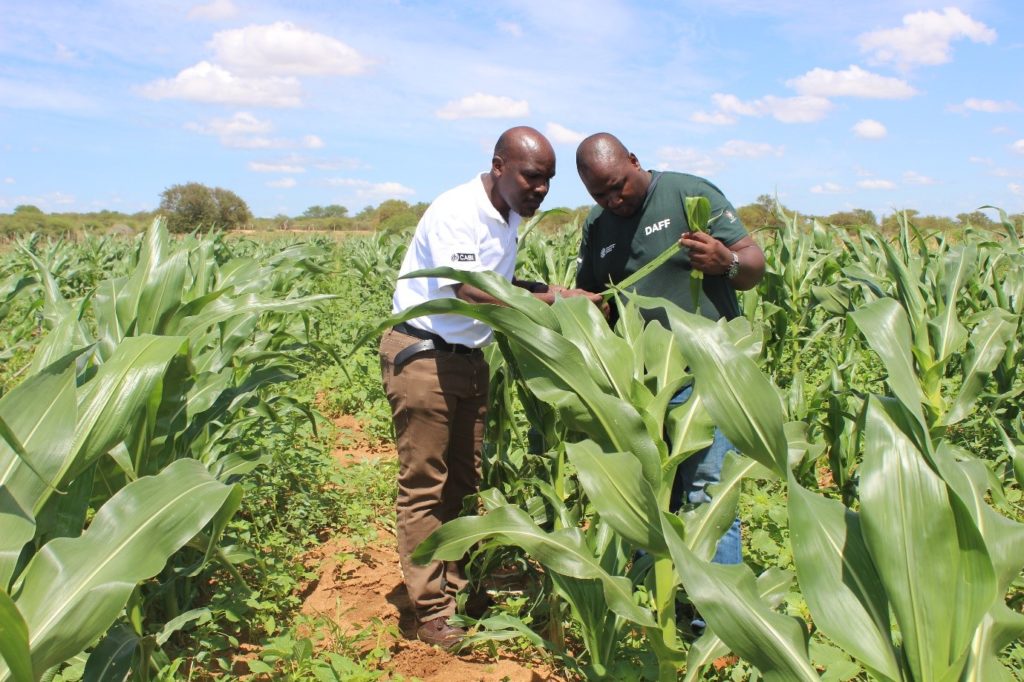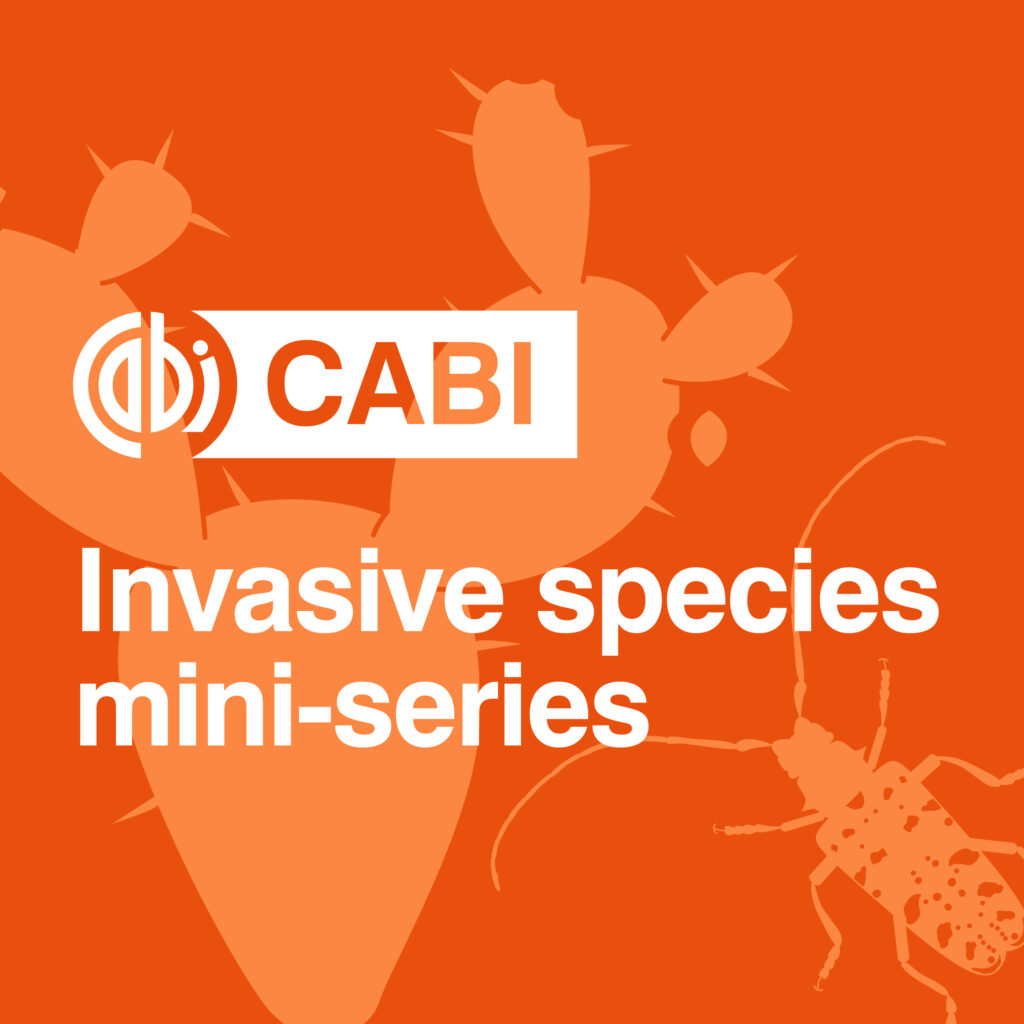In 2016, fall armyworm (Spodoptera frugiperda) was found in Africa for the first time. This nefarious invasive species feeds on a vast range of plants, causing major damage. Since then, CABI has been working hard in the fight against fall armyworm, including international and national response planning, biological control research and development, mass extension and diagnostic services.
As part of the CABI Podcast invasive species mini-series, we interviewed CABI expert’s Dr Roger Day and Dr Ivan Rwomushana to discover more about this devastating pest and CABI’s work to control it.

Welcome Dr Day and Dr Rwomushana. Please, tell us about yourselves…
Dr Roger Day: I’m in charge of the Action on Invasives programme which is looking to address the whole problem of invasive species. I’m an entomologist by training and been working in invasive species for something like 40 years now, in both Asia and Africa.
Dr Ivan Rwomushana: I’m a senior scientist for invasive species management, currently based at CABI business centre in Nairobi. My background is entomology. I’ve been working on Fall Armyworm management for the last couple of years
Fall armyworm has invaded many regions in Africa, Asia and the Pacific. Where is this caterpillar native to?
Dr Roger Day: It’s a tropical species which in the winter in America is confined to the southern parts of Florida and Texas, and also lives in central and southern America.
How has it travelled to these invaded regions?
Dr Roger Day: Well, how it reached West Africa is an open question. It probably couldn’t fly that far, although it can fly long distances on the prevailing wind. It’s been recorded flying several hundred kilometres in a night with a favourable wind. But it’s likely that it reached West Africa on a boat or a plane, some kind of transport as a contaminant. After that, it probably spread by natural flight because it spread so rapidly.
It has proven to be an extremely successful invasive pest. Why is this?
Dr Ivan Rwomushana: It is a very successful pest for a number of reasons, and the first one is that it has a very wide host range. It has been reported to feed on more than 80 plant hosts. And secondly the conditions upon which it can survive are quite varied and they’re wide. And typically, when it comes to areas where it is not native, like Africa, for instance, there are not many natural enemies that can keep it in check.
We’ve mentioned that fall armyworm’s impact can be devastating, but who is most impacted by its arrival?
Dr Ivan Rwomushana: Smallholder farmers are the most affected by this pest because it typically feeds on the food crops that they feed on, on a daily basis. It’s been known to attack maize fields and wheat fields. And so typically this is a big loss in terms of the food that farmers would typically have for their own consumption and also for sale and getting some of their basic necessities.

CABI has been working hard to develop methods of controlling fall armyworm, including work on biocontrols. Can you tell us more about them?
Dr Roger Day: So usually when we talk about biological control, we mean using other living organisms to control a pest and the other living organisms are what we call natural enemies. These can be of several sorts including other insects which either parasitize or prey on the Fall Armyworm. There are also various different microbes which are like diseases which infect and kill the Armyworm.
So, the first approach is to see if there are natural enemies where Fall Armyworm is in Africa and Asia, that are already attacking the Fall Armyworm and we can try and conserve those or encourage them so we should avoid killing them which of course pesticides do. Another approach is to mass rear large numbers of the natural enemies and release them into the field when you’ve got a problem. This is called augmentation, and this is typically done for Fall Armyworm with very tiny wasps which lay their eggs inside the eggs of Fall Armyworm and by parasitizing the Armyworm egg, it obviously kills it. There’s an approach called classical or introduction biological control where we look in the area where the pest originates, so in this case in the Americas, and see which natural enemies are attacking it there. Obviously, that can only be done with lots of safety tests to make sure that the introduced natural enemy doesn’t attack non-target hosts.
Are any of these methods currently under trial?
Dr Ivan Rwomushana: We trialled a virus … typically how they work is that the caterpillar would pick up the parasite through feeding, and get infected with a virus and once its infected it stops feeding and eventually it will die off. But also Fall Armyworm caterpillars are known to predate against each other, they cannibalize each other and so when a healthy caterpillar feeds on a sick caterpillar it can get infected and eventually die off.
Also in Kenya, recently, there’s been a pheromone for mating disruptions has been registered for use against Fall Armyworm, and typically how this works is that when you apply the pheromone in the field, it releases certain info chemicals that confuse – the info chemicals get into the environment, into the maize field and they confuse the males from finding the females, and so if the males can’t find the females it means the females’ eggs will not be fertilized.
Listen to this podcast episode
CABI podcast mini-series
Thank you to Dr Roger Day and Dr Ivan Rwomushana for discussing their work to tackle the invasive fall armyworm. This interview was taken from the CABI podcast mini-series.

The CABI podcast is a series of four podcasts dedicated to discovering more about the devastating economic, environmental and social impacts invasive species have and what we can do to manage them.
The series is available to listen to via the link below or find it on most major streaming services – just search CABI podcast invasive species.
Further reading
Find out more about fall armyworm and its management on the Invasive Species Compendium
Are you a fall armyworm researcher? The Fall Armyworm Research Collaboration Portal has been created to help fall armyworm researchers to build research networks. Find out more
Related News & Blogs
What makes invasive apple snail the worst invasive invertebrate of waterways?
This article was originally published on CABI Digital Library Overview: What is the invasive apple snail? The invasive apple snail is a large freshwater snail with a large variation in shell colour. This species is in the ‘top 100 worst invasive specie…
10 April 2024




